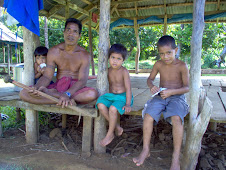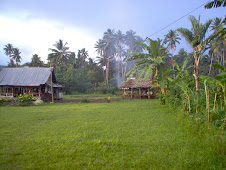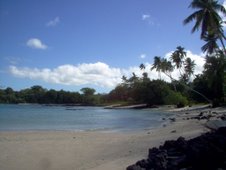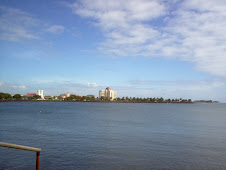Saturday, September 8, 2012
Back to Samoa for a Visit
I'm going back to Samoa for a visit two weeks from today! It will be great to see my Samoan family. When I was back last time it was only eight months after the tsunami, and life wasn't even close to being back to normal for the people there. Now things will be more settled.
Monday, July 19, 2010
Sekia!
In a word, my trip to Samoa was “wonderful.” I’m so very lucky that I was placed with my particular Samoan family when I was in Peace Corps. I had sent an email with my itinerary and had a couple of brief phone conversations with my Samoan family before I left Hawaii ($45 for two phone calls of about ten minutes each). But other than the fact that I knew that they knew that I was coming for a visit, I had made no other plans. I took a taxi from the airport directly to the bakery/restaurant/store which my family owns. I was welcomed with hugs and kisses, was given a sandwich and cool drink, and then took a taxi to grandmother’s house in Apia. From that time on, I was in the bosom of the family and wanted for nothing the entire time that I was there.
That evening we went to Poutasi. It was difficult to see the village so changed. Our family house was very badly damaged, but part of the rear portion remains, with intact plumbing in the bathroom. So the family has been living in that part of the house. All the windows and some of the walls were blown out in the tsunami, so it’s open on three sides, although they have put up boards to provide some shelter. They are building a new house in the village, on higher ground. It is nearly complete, but still didn’t have plumbing during my visit, so they weren’t living there yet. Saina (the mom in my host family) will have an indoor kitchen sink and a four burner stovetop for the first time ever. But they also plan to rebuild the old house as a place to come by the sea, and for guests and family. There are numerous new houses in the village, mostly on the mountain instead of by the sea where they used to be, and lots of open space where houses once stood.
My visit brought closure for me in more ways than I expected. It helped to be able to see the village, changed as it is, and accept it as it now stands, and to mourn the loss of my friends. But unexpectedly I found some closure to my Peace Corps experience. When I first got to Samoa in 2007, I wrote in my journal that “. . . my only real concern is whether I will be able to accomplish a worthwhile project in my village when I get there.” So to return and sense some measure of accomplishment, and know that I made a small difference, is a good feeling.
When I returned to Poutasi, I learned that the Homework Center continued successfully after I left. On weekends it was a busy place where the children continued to come and do homework and spend time on the computers. Some of the village teachers staffed it. It’s hard for Samoan kids to do homework at home – there are always chores that they are asked to do, little brothers and sisters to baby-sit, etc. At the homework center they could come and work together in a place set aside for that purpose. And the little kids could come too and color, do puzzles, etc., like they did while I was there.
And here’s one of the coolest things. In the new church hall, under construction, there is planned a new homework center. It will be bigger and better and air conditioned. They will continue to welcome kids from Poutasi and the neighboring village to come and do homework and use the computers for free (with charges only for printing and copying). I can hardly express how delighted I am that this little project is continuing.
So I was really excited to give the money that I took with me from your generous gifts ($500 US), to the Poutasi Homework Center. One of the Peace Corps office staff also raised $1,300 US that she wants to be used for the kids in Poutasi. I introduced her to Saina, and the day after I left they met to begin planning a fun day for the kids in September where they will have crafts, games, prizes, food, music, and dancing, I wish that I could be there! A portion of that money will also go to the Poutasi Homework Center. Later, when the construction on the church hall is complete, and the homework center is ready to re-open, I’ll send some books, puzzles, etc. to replace some of what was lost in the tsunami. (A couple of you have said that you would still like to contribute – you could help me buy stuff for a box to send later.)
I am absolutely delighted with how this has turned out! There will be a new community internet center in the village, but the kids can still have the opportunity they had before. They can still have free computer time; they can come to do homework together; they will have a learning space. The Poutasi Homework Center will continue.
That evening we went to Poutasi. It was difficult to see the village so changed. Our family house was very badly damaged, but part of the rear portion remains, with intact plumbing in the bathroom. So the family has been living in that part of the house. All the windows and some of the walls were blown out in the tsunami, so it’s open on three sides, although they have put up boards to provide some shelter. They are building a new house in the village, on higher ground. It is nearly complete, but still didn’t have plumbing during my visit, so they weren’t living there yet. Saina (the mom in my host family) will have an indoor kitchen sink and a four burner stovetop for the first time ever. But they also plan to rebuild the old house as a place to come by the sea, and for guests and family. There are numerous new houses in the village, mostly on the mountain instead of by the sea where they used to be, and lots of open space where houses once stood.
My visit brought closure for me in more ways than I expected. It helped to be able to see the village, changed as it is, and accept it as it now stands, and to mourn the loss of my friends. But unexpectedly I found some closure to my Peace Corps experience. When I first got to Samoa in 2007, I wrote in my journal that “. . . my only real concern is whether I will be able to accomplish a worthwhile project in my village when I get there.” So to return and sense some measure of accomplishment, and know that I made a small difference, is a good feeling.
When I returned to Poutasi, I learned that the Homework Center continued successfully after I left. On weekends it was a busy place where the children continued to come and do homework and spend time on the computers. Some of the village teachers staffed it. It’s hard for Samoan kids to do homework at home – there are always chores that they are asked to do, little brothers and sisters to baby-sit, etc. At the homework center they could come and work together in a place set aside for that purpose. And the little kids could come too and color, do puzzles, etc., like they did while I was there.
And here’s one of the coolest things. In the new church hall, under construction, there is planned a new homework center. It will be bigger and better and air conditioned. They will continue to welcome kids from Poutasi and the neighboring village to come and do homework and use the computers for free (with charges only for printing and copying). I can hardly express how delighted I am that this little project is continuing.
So I was really excited to give the money that I took with me from your generous gifts ($500 US), to the Poutasi Homework Center. One of the Peace Corps office staff also raised $1,300 US that she wants to be used for the kids in Poutasi. I introduced her to Saina, and the day after I left they met to begin planning a fun day for the kids in September where they will have crafts, games, prizes, food, music, and dancing, I wish that I could be there! A portion of that money will also go to the Poutasi Homework Center. Later, when the construction on the church hall is complete, and the homework center is ready to re-open, I’ll send some books, puzzles, etc. to replace some of what was lost in the tsunami. (A couple of you have said that you would still like to contribute – you could help me buy stuff for a box to send later.)
I am absolutely delighted with how this has turned out! There will be a new community internet center in the village, but the kids can still have the opportunity they had before. They can still have free computer time; they can come to do homework together; they will have a learning space. The Poutasi Homework Center will continue.
Sunday, May 23, 2010
Return to Samoa
On Friday, May 28th, I'll return to Samoa for a visit and come back to Hawaii on June 11th.
As I mentioned previously, I’ve been trying to raise some money to help with a new computer center in my village which is going to be in the old headmaster’s house near the high school. I’m blessed with so many great friends; I’ve received $565 in the mail. But that’s not the only amazing thing.
There is a Peace Corps volunteer (Erica) who is still in Samoa who lived in a village several miles down the road from Poutasi. I say lived, because she literally out ran the tsunami when it swept into her village, and the house where she was living was destroyed. Through her help and an organization called Peace Corps Partnership we have raised an additional $2,700! The money is intended to help purchase some equipment for the computer center. It should buy at least two copier/printer machines. I can’t say fa’afetai (thank you) enough to everyone who helped out.
It’s been eight months since the tsunami. I’m looking forward to seeing everyone there, but I’m apprehensive about seeing the village. It will forever be in my memory as it was before the tsunami, especially since that’s the way it was during my Peace Corps experience. But it will never be that way again, and I have to get used to that idea too.
I’ll send an update from Samoa. Maybe this will be the stimulus I need to take my 300+ page journal, written while I was in Peace Corps, and turn it into something that people might want to read, or maybe just a memoir for me and my family.
As always, thanks for your interest and your support.
As I mentioned previously, I’ve been trying to raise some money to help with a new computer center in my village which is going to be in the old headmaster’s house near the high school. I’m blessed with so many great friends; I’ve received $565 in the mail. But that’s not the only amazing thing.
There is a Peace Corps volunteer (Erica) who is still in Samoa who lived in a village several miles down the road from Poutasi. I say lived, because she literally out ran the tsunami when it swept into her village, and the house where she was living was destroyed. Through her help and an organization called Peace Corps Partnership we have raised an additional $2,700! The money is intended to help purchase some equipment for the computer center. It should buy at least two copier/printer machines. I can’t say fa’afetai (thank you) enough to everyone who helped out.
It’s been eight months since the tsunami. I’m looking forward to seeing everyone there, but I’m apprehensive about seeing the village. It will forever be in my memory as it was before the tsunami, especially since that’s the way it was during my Peace Corps experience. But it will never be that way again, and I have to get used to that idea too.
I’ll send an update from Samoa. Maybe this will be the stimulus I need to take my 300+ page journal, written while I was in Peace Corps, and turn it into something that people might want to read, or maybe just a memoir for me and my family.
As always, thanks for your interest and your support.
Monday, March 8, 2010
Village Clean-Up
FROM THE SAMOA OBSERVER
Tsunami clean-up begins
Sunday, 07 March 2010
Hundreds of volunteers, supported by the expatriate Australian community (and the odd Kiwi) turned up at Poutasi yesterday for the start of the tsunami clean-up.
Teams scoured the mangroves, waded through the lagoon and scrambled over the rocks to rescue the reef and retrieve tonnes of debris and other rubbish.
Led by MNRE and with the support of DMO, Fire and Emergency Services, the Red Cross, the crew from MV NAFANUA and the matai of Poutasi, the clean up was declared a big success.
“It was a wonderful day and proved that, occasionally, people power can match the destructive force of nature,” said Australian High Commissioner Matt Anderson.
“It was also a reminder that Australia (and Australians) stand ready to assist Samoa wherever and whenever there’s a need.”
Tsunami clean-up begins
Sunday, 07 March 2010
Hundreds of volunteers, supported by the expatriate Australian community (and the odd Kiwi) turned up at Poutasi yesterday for the start of the tsunami clean-up.
Teams scoured the mangroves, waded through the lagoon and scrambled over the rocks to rescue the reef and retrieve tonnes of debris and other rubbish.
Led by MNRE and with the support of DMO, Fire and Emergency Services, the Red Cross, the crew from MV NAFANUA and the matai of Poutasi, the clean up was declared a big success.
“It was a wonderful day and proved that, occasionally, people power can match the destructive force of nature,” said Australian High Commissioner Matt Anderson.
“It was also a reminder that Australia (and Australians) stand ready to assist Samoa wherever and whenever there’s a need.”
Thursday, January 28, 2010
A New Computer Center For Poutasi
Aloha! After a vagabond year I’m back in Hawaii. It was wonderful to spend a lot of time with family on the mainland. With one son in Atlanta, one in Colorado, and the other in San Diego, I literally went from coast to coast, thoroughly enjoying my time with each of them and their families. I was also able to spend a lot of precious time with my mother in Colorado.
After the tsunami in Samoa I mentioned that I would like to organize an effort to help my village of Poutasi, especially the kids in the village. One of my major projects in the village was the homework/computer center. We turned a storeroom in the rear of the church hall into a small computer center (see photos on the right side of this blog). We had three donated used computers, and one laptop. We got a grant from the New Zealand High Commission of approximately $2,000US, which we used to purchase a printer and pay for some of the renovation cost. The village provided labor and the remainder of the materials.
It was in this small center that I spent two or more afternoons a week and Saturday mornings with the kids teaching them to use the computers, helping them with school work, and providing a learning place for them to hang out. Often there would be 12 or 15 kids waiting for me when I got there. They would double up and sit two in front of each computer. While waiting for their turn, they sat on the floor and colored, did puzzles, read books, or played games. Thanks to generous donations from friends in the States, we were able to provide these educational materials for them.
I taught the kids basic computer skills and installed educational games on the computers. There were mouse practice games, typing games, and math and language games. They loved it and it was such a joy to see them there. Some days I would be tired and think, “I don’t want to go to the computer center this afternoon.” Then I would go and spend two or three hours and be totally energized by being with them.
The church hall was badly damaged in the tsunami. It’s structurally unsound and is being demolished. However, often there is opportunity in crisis. There is a two-story house that at one time was the headmaster’s house for the school when they sent teachers to Samoa from New Zealand. While I was living in the village, Tuatagaloa Joe and his wife, Tui (Joe is my family’s chief and high chief of the village, and Tui was my dear friend and cousin who was killed in the tsunami), talked to me about using that house to create a “real” computer center. If I had been able to stay longer in Samoa I would have worked toward that goal. I had initial conversations with some folks about it, but that was all that I was able to accomplish while I was there.
Now, after the tsunami, a group of young men from New Zealand have come to the village to help, and they are remodeling and restoring the house for a computer center. There will be a small apartment upstairs so that someone can live above the computer center to provide supervision and security. And it is on the main road so there is a phone line nearby making it possible for them to be on the internet (my little computer center wasn’t on the net).
Tuatagaloa Joe will be sending me some photos and more details on the renovation progress soon. I’ll post that information as soon as I get it.
Many people have told me that they would like to make a donation, so I’m working to raise some funds to help make this new computer center a reality. If you would like to help Poutasi in this way, you can contact me at kona_malia@yahoo.com. Fa’afetai tele lava! (Thank you very much!)
After the tsunami in Samoa I mentioned that I would like to organize an effort to help my village of Poutasi, especially the kids in the village. One of my major projects in the village was the homework/computer center. We turned a storeroom in the rear of the church hall into a small computer center (see photos on the right side of this blog). We had three donated used computers, and one laptop. We got a grant from the New Zealand High Commission of approximately $2,000US, which we used to purchase a printer and pay for some of the renovation cost. The village provided labor and the remainder of the materials.
It was in this small center that I spent two or more afternoons a week and Saturday mornings with the kids teaching them to use the computers, helping them with school work, and providing a learning place for them to hang out. Often there would be 12 or 15 kids waiting for me when I got there. They would double up and sit two in front of each computer. While waiting for their turn, they sat on the floor and colored, did puzzles, read books, or played games. Thanks to generous donations from friends in the States, we were able to provide these educational materials for them.

I taught the kids basic computer skills and installed educational games on the computers. There were mouse practice games, typing games, and math and language games. They loved it and it was such a joy to see them there. Some days I would be tired and think, “I don’t want to go to the computer center this afternoon.” Then I would go and spend two or three hours and be totally energized by being with them.
The church hall was badly damaged in the tsunami. It’s structurally unsound and is being demolished. However, often there is opportunity in crisis. There is a two-story house that at one time was the headmaster’s house for the school when they sent teachers to Samoa from New Zealand. While I was living in the village, Tuatagaloa Joe and his wife, Tui (Joe is my family’s chief and high chief of the village, and Tui was my dear friend and cousin who was killed in the tsunami), talked to me about using that house to create a “real” computer center. If I had been able to stay longer in Samoa I would have worked toward that goal. I had initial conversations with some folks about it, but that was all that I was able to accomplish while I was there.
Now, after the tsunami, a group of young men from New Zealand have come to the village to help, and they are remodeling and restoring the house for a computer center. There will be a small apartment upstairs so that someone can live above the computer center to provide supervision and security. And it is on the main road so there is a phone line nearby making it possible for them to be on the internet (my little computer center wasn’t on the net).
Tuatagaloa Joe will be sending me some photos and more details on the renovation progress soon. I’ll post that information as soon as I get it.
Many people have told me that they would like to make a donation, so I’m working to raise some funds to help make this new computer center a reality. If you would like to help Poutasi in this way, you can contact me at kona_malia@yahoo.com. Fa’afetai tele lava! (Thank you very much!)
Thursday, December 31, 2009
HAWAI'I CALLS
Gardenias' fragrances float in the tropical air.
Breezes sigh in the ironwood trees.
Spring moon is shining full.
Frogs call and crickets chirp.
As the moon pulls on the tides tonight
Drawing them closer to her,
I feel Hawai'i tugging on my soul,
Drawing me closer to her.
Islands of gentle showers and soft green,
Pahoehoe and a'a,
Mountains soaring, rivers roaring,
Forests of rain, and deep waters.
I need to be comforted by your softness,
Challenged by your rugged solitude,
And nestled in your warm bosom,
Renewed and held in the spell of your tropical nights.
Friday, December 25, 2009
Back to the Islands
On January 7th I'll finally be settling in back on the Big Island of Hawaii. I miss the island life and am getting anxious to be back. I hope to travel to Samoa in the spring.
Manuia le Kirisimasi, Mele Kalikimaka, Merry, Merry Christmas to all!
Manuia le Kirisimasi, Mele Kalikimaka, Merry, Merry Christmas to all!
Life Goes On
It’s been nearly three months since the tsunami in Samoa. The immediate crisis is past. Houses and lives are being rebuilt. Here’s the email I recently received from my Samoan family:
Dear Donna,
Sorry for delaying in replying your Email. Kids are very happy with
their gifts. We also very happy and would like to thank you very much
indeed for all this you have done for us. Hemara is very like to write to you.
Regarding Tsunami, We are now starting to plan for a new house at the
roadside. I am trying to get some money loan from the Bank to add on the
assistance given by the government, then probably starting the
construction work by next month.
Best regards from Saina, Hemara, Tia and Fetu
Tofa Soifua
Lesaisaea Niualuga
When a Peace Corps volunteer in Samoa is assigned to a village, it’s the responsibility of the village to provide a place for the volunteer to live. I had initially been told, as I had requested, that I would have a place by myself. I was dismayed to learn just a few days before I went to Poutasi that I would be living with a family in the village.
As a group of 16 volunteers we had gone through training together for three months. Then we were taken to our individual villages. I vividly remember that day when we arrived in Poutasi and I was introduced to my Samoan family. Then the Peace Corps vehicle drove away and there I was. In a strange house, with people I didn’t know. I don’t know that I’ve ever felt so alone.
But sometimes we don’t know what’s best for us. When it was time to come back to the States the next year, it was so hard to leave my Samoan family. We hugged and kissed and cried together. I know for a fact that my experience there was enriched immensely by having been a part of this family.
In Samoa, as in all of Polynesia, if you are related by blood (even the remotest cousin), or by adoption (formal or otherwise), or by marriage, or by simply being welcomed into the family, you are family, now and forever.
I lived in Poutasi with Lesaisaea Niualuga Evaimalo, his wife, Saina, and their children. Saina’s father, Tuatagaloa Te’o Fetu, was high chief of Poutasi and the Falealili District (12 villages on the southern coast of the Island of Upolu) for decades. When he passed away in the 1990’s, the family chose a new matai (chief), Joe Annandale, who then became Tuatagaloa Joe Annandale. The Annandale ancestor came to Samoa from Scotland, and in 1873 married a Samoan princess, the niece of King Malietoa.
In Samoa there is what is known as “customary land.” Every Samoan family has a swath of land that runs from the sea to the mountain which has been their family’s land for hundreds of years. They don’t have title to it; they can’t sell it or lease it. It’s the family land. Usually several households live on the family land in individual houses. One family in Poutasi had over 50 family members living together in different houses, including the 80-year-old matriarch of the family and her children and their children and their children.
As I said, Saina’s father was the Tuatagaloa high chief for many years. After her father’s death, her mother moved to Apia to live with family there. Saina married Niu and they now live in the family house in Poutasi where I stayed. Tuatagaloa Joe, the current high chief, and his wife Tui lived in their house next door.
Saina and Niu's have six children. Three of them lived with us in Poutasi. Their oldest daughter is grown with a family of her own. Son Stephen is attending high school in California and lives with family there, and daughter Aileen lived with her aunt and uncle in Apia. Throughout Polynesia children are commonly entrusted to relatives. In America we associate foster parenting or adoption with something gone wrong. In Samoa it's like a redistribution of children, to those with no children, or to a family who might be able to provide more ample means of support. These transfers of children aren’t absolute, and although the fosterage may last for years, they don’t permanently separate the children from their biological parents, who have a deep and lasting commitment to their children. It’s hard for us to understand, and likewise, the thought that we have orphanages is appalling to Samoans.
(Aileen is now attending Alabama State University in Montgomery on scholarship and I was able to spend some time with her when visiting my son in Atlanta for Thanksgiving.)
The younger children in our family, Hemara, Tia, and Fetu, lived with us in Poutasi. Hemara and Tia, attended St. Mary’s Primary School, a private school in Apia. Hemara turned 11 soon after I got there and is now 13. She and I became especially close. Youngest son, Fetu, has a learning disability (Saina has diabetes, which was diagnosed during her pregnancy with Fetu, and such high risk pregnancies often result in developmental delay, learning difficulties and ADHD). When I first came to the village, Fetu, at age 7, was not attending school at all. They had tried to send him to the local school, but teachers in Samoan village schools don't have the training to deal with such a situation. I encouraged and worked with Saina, and we were able about one year later to get Fetu into a private school in Apia, where he would get the extra help he needed. It’s very fortunate that the family has the resources to send the children to private schools. If not, Fetu would just not have gone to school.
My Samoan family is wealthy by Samoan standards. Saina’s family owns a bakery, small grocery store, and restaurant in Apia. Saina works at the store. Niu was originally from another village. (In Samoa you don’t marry someone from your own village.) He got his Bachelor’s degree from the University of the South Pacific in Fiji in Environmental Science. When I first arrived in the village, Niu was in charge of the National Park in Samoa. While I was there he got a promotion and he is now head of Waste Management for the Ministry of Natural Resources and Environment. Joe and Tui owned Sinalei (http://www.sinalei.ws/), a small resort a few miles away, which was a real treat for me to visit occasionally. (Both the Ministry and the resort have internet access so we can continue to keep in touch via email.)
Because of the wealth and the status of my Samoan family, I felt kind of guilty at first that my life was cushier and more comfortable than most of the other Peace Corps volunteers in country. But after a time, I realized that this was my Peace Corps experience, and other volunteers would have a different experience, and that was okay.
And of course it’s all still relative. We lived in one of the nicest houses in the village. But we still had no hot water, and cold water intermittently. The family did most of the cooking over an open fire in the cookhouse out back, since we had only a one-burner propane cook top in the house, and no stove. We had a refrigerator when I first moved there, but it died about three months before I left and hadn’t been replaced yet. The laundry was done either at the sink, which was outside next to the house, or in buckets in the shower stall.
Well, I digress. My Samoan family is doing well under the circumstances. Joe is recovering from his injuries and plans to repair and reopen Sinalei by April 2010. Tui will be missed forever, but Joe has a lot of family support. I talked to Niu and Saina by telephone several days after the tsunami. Their new house will be located on family land away from the ocean front and along the government road slightly higher in elevation. The children are doing well. Saina said that Hemara was angry because she had written a letter to me which hadn’t yet been mailed, and it was washed away.
I haven’t worked out the details yet, but I am continuing to plan to raise some money to reopen the homework center/computer center. I was so pleased that they had kept it going after I left, and even added another room for a quiet study area and library. If I could raise enough money (probably about $2,000 to do repairs and replace the computers), I’d like to go back for a few weeks next spring or summer and set it up again. I’m waiting to hear back from Joe and Niu about the structural integrity of the church hall. The computer center was in the back of the building; the front was badly damaged. There is one other building in the village that is a possible location, but it would need much more repair.
Geography Postscript
After the tsunami I had questions from a number of you about the size of the Samoan Islands. Here’s a bit of information about Samoa and American Samoa. The eastern group of islands, the territory of American Samoa, has a population of about 55,000. The total land area of American Samoa is 77 square miles made up of seven very small islands. The largest island (Tutuila) has a land area of 57 square miles. It also has a large natural harbor (Pago Pago), which is why the United States wanted it for a naval re-fueling station.
Forty-miles away is the independent country of Samoa (formerly known as Western Samoa) with a total population of about 188,000 and a total land area of 1,133 square miles. Comparatively, the area occupied by Samoa is slightly smaller than the State of Rhode Island. There are four inhabited islands. I lived on the Island of Upolu which is 430 square miles. It’s the most populated island and second largest island, 47 miles long and 15 miles wide. There is one city on the island, Apia (pop. 61,900), which is really an agglomeration of small villages. Seventy percent of the population lives in small villages on the coast.
Dear Donna,
Sorry for delaying in replying your Email. Kids are very happy with
their gifts. We also very happy and would like to thank you very much
indeed for all this you have done for us. Hemara is very like to write to you.
Regarding Tsunami, We are now starting to plan for a new house at the
roadside. I am trying to get some money loan from the Bank to add on the
assistance given by the government, then probably starting the
construction work by next month.
Best regards from Saina, Hemara, Tia and Fetu
Tofa Soifua
Lesaisaea Niualuga
When a Peace Corps volunteer in Samoa is assigned to a village, it’s the responsibility of the village to provide a place for the volunteer to live. I had initially been told, as I had requested, that I would have a place by myself. I was dismayed to learn just a few days before I went to Poutasi that I would be living with a family in the village.
As a group of 16 volunteers we had gone through training together for three months. Then we were taken to our individual villages. I vividly remember that day when we arrived in Poutasi and I was introduced to my Samoan family. Then the Peace Corps vehicle drove away and there I was. In a strange house, with people I didn’t know. I don’t know that I’ve ever felt so alone.
But sometimes we don’t know what’s best for us. When it was time to come back to the States the next year, it was so hard to leave my Samoan family. We hugged and kissed and cried together. I know for a fact that my experience there was enriched immensely by having been a part of this family.
In Samoa, as in all of Polynesia, if you are related by blood (even the remotest cousin), or by adoption (formal or otherwise), or by marriage, or by simply being welcomed into the family, you are family, now and forever.
I lived in Poutasi with Lesaisaea Niualuga Evaimalo, his wife, Saina, and their children. Saina’s father, Tuatagaloa Te’o Fetu, was high chief of Poutasi and the Falealili District (12 villages on the southern coast of the Island of Upolu) for decades. When he passed away in the 1990’s, the family chose a new matai (chief), Joe Annandale, who then became Tuatagaloa Joe Annandale. The Annandale ancestor came to Samoa from Scotland, and in 1873 married a Samoan princess, the niece of King Malietoa.
In Samoa there is what is known as “customary land.” Every Samoan family has a swath of land that runs from the sea to the mountain which has been their family’s land for hundreds of years. They don’t have title to it; they can’t sell it or lease it. It’s the family land. Usually several households live on the family land in individual houses. One family in Poutasi had over 50 family members living together in different houses, including the 80-year-old matriarch of the family and her children and their children and their children.
As I said, Saina’s father was the Tuatagaloa high chief for many years. After her father’s death, her mother moved to Apia to live with family there. Saina married Niu and they now live in the family house in Poutasi where I stayed. Tuatagaloa Joe, the current high chief, and his wife Tui lived in their house next door.
Saina and Niu's have six children. Three of them lived with us in Poutasi. Their oldest daughter is grown with a family of her own. Son Stephen is attending high school in California and lives with family there, and daughter Aileen lived with her aunt and uncle in Apia. Throughout Polynesia children are commonly entrusted to relatives. In America we associate foster parenting or adoption with something gone wrong. In Samoa it's like a redistribution of children, to those with no children, or to a family who might be able to provide more ample means of support. These transfers of children aren’t absolute, and although the fosterage may last for years, they don’t permanently separate the children from their biological parents, who have a deep and lasting commitment to their children. It’s hard for us to understand, and likewise, the thought that we have orphanages is appalling to Samoans.
(Aileen is now attending Alabama State University in Montgomery on scholarship and I was able to spend some time with her when visiting my son in Atlanta for Thanksgiving.)
The younger children in our family, Hemara, Tia, and Fetu, lived with us in Poutasi. Hemara and Tia, attended St. Mary’s Primary School, a private school in Apia. Hemara turned 11 soon after I got there and is now 13. She and I became especially close. Youngest son, Fetu, has a learning disability (Saina has diabetes, which was diagnosed during her pregnancy with Fetu, and such high risk pregnancies often result in developmental delay, learning difficulties and ADHD). When I first came to the village, Fetu, at age 7, was not attending school at all. They had tried to send him to the local school, but teachers in Samoan village schools don't have the training to deal with such a situation. I encouraged and worked with Saina, and we were able about one year later to get Fetu into a private school in Apia, where he would get the extra help he needed. It’s very fortunate that the family has the resources to send the children to private schools. If not, Fetu would just not have gone to school.
My Samoan family is wealthy by Samoan standards. Saina’s family owns a bakery, small grocery store, and restaurant in Apia. Saina works at the store. Niu was originally from another village. (In Samoa you don’t marry someone from your own village.) He got his Bachelor’s degree from the University of the South Pacific in Fiji in Environmental Science. When I first arrived in the village, Niu was in charge of the National Park in Samoa. While I was there he got a promotion and he is now head of Waste Management for the Ministry of Natural Resources and Environment. Joe and Tui owned Sinalei (http://www.sinalei.ws/), a small resort a few miles away, which was a real treat for me to visit occasionally. (Both the Ministry and the resort have internet access so we can continue to keep in touch via email.)
Because of the wealth and the status of my Samoan family, I felt kind of guilty at first that my life was cushier and more comfortable than most of the other Peace Corps volunteers in country. But after a time, I realized that this was my Peace Corps experience, and other volunteers would have a different experience, and that was okay.
And of course it’s all still relative. We lived in one of the nicest houses in the village. But we still had no hot water, and cold water intermittently. The family did most of the cooking over an open fire in the cookhouse out back, since we had only a one-burner propane cook top in the house, and no stove. We had a refrigerator when I first moved there, but it died about three months before I left and hadn’t been replaced yet. The laundry was done either at the sink, which was outside next to the house, or in buckets in the shower stall.
Well, I digress. My Samoan family is doing well under the circumstances. Joe is recovering from his injuries and plans to repair and reopen Sinalei by April 2010. Tui will be missed forever, but Joe has a lot of family support. I talked to Niu and Saina by telephone several days after the tsunami. Their new house will be located on family land away from the ocean front and along the government road slightly higher in elevation. The children are doing well. Saina said that Hemara was angry because she had written a letter to me which hadn’t yet been mailed, and it was washed away.
I haven’t worked out the details yet, but I am continuing to plan to raise some money to reopen the homework center/computer center. I was so pleased that they had kept it going after I left, and even added another room for a quiet study area and library. If I could raise enough money (probably about $2,000 to do repairs and replace the computers), I’d like to go back for a few weeks next spring or summer and set it up again. I’m waiting to hear back from Joe and Niu about the structural integrity of the church hall. The computer center was in the back of the building; the front was badly damaged. There is one other building in the village that is a possible location, but it would need much more repair.
Geography Postscript
After the tsunami I had questions from a number of you about the size of the Samoan Islands. Here’s a bit of information about Samoa and American Samoa. The eastern group of islands, the territory of American Samoa, has a population of about 55,000. The total land area of American Samoa is 77 square miles made up of seven very small islands. The largest island (Tutuila) has a land area of 57 square miles. It also has a large natural harbor (Pago Pago), which is why the United States wanted it for a naval re-fueling station.
Forty-miles away is the independent country of Samoa (formerly known as Western Samoa) with a total population of about 188,000 and a total land area of 1,133 square miles. Comparatively, the area occupied by Samoa is slightly smaller than the State of Rhode Island. There are four inhabited islands. I lived on the Island of Upolu which is 430 square miles. It’s the most populated island and second largest island, 47 miles long and 15 miles wide. There is one city on the island, Apia (pop. 61,900), which is really an agglomeration of small villages. Seventy percent of the population lives in small villages on the coast.
Sunday, October 25, 2009
Filipo in Happier Times
Filipo is the young man in the CNN video below talking about the tsunami in Poutasi. Here are some photos that I took last year of Filipo scraping the skin off a breadfruit with a tuna can and making freshly squeezed coconut milk for a village celebration.
Subscribe to:
Comments (Atom)
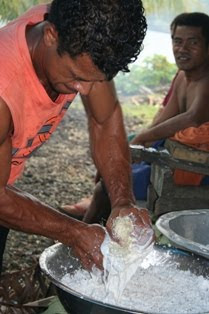

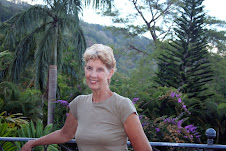
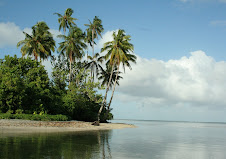
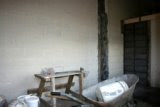
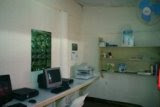
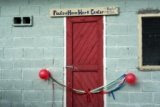
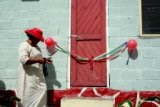
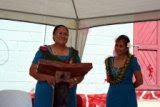
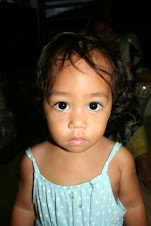
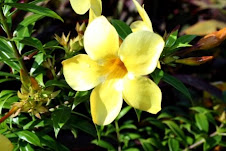
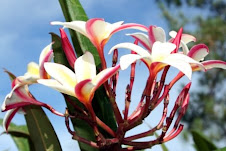
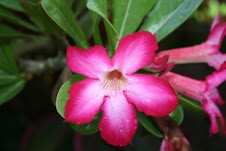

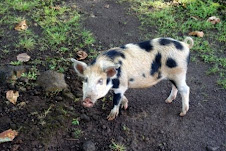

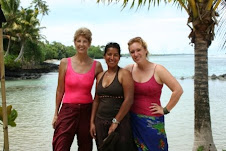

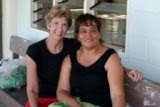

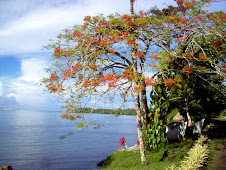
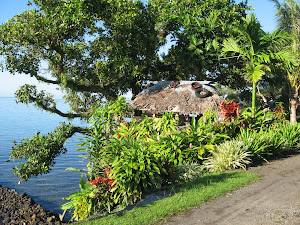
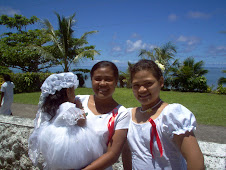
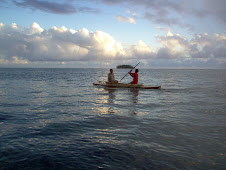

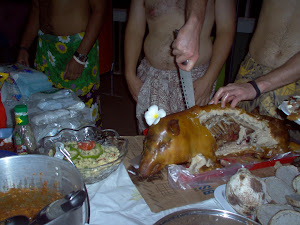
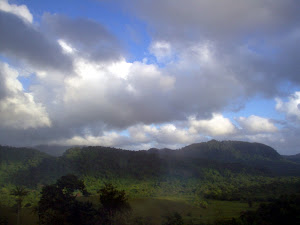
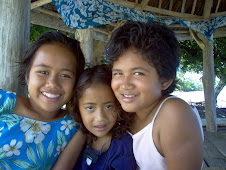.jpg)
